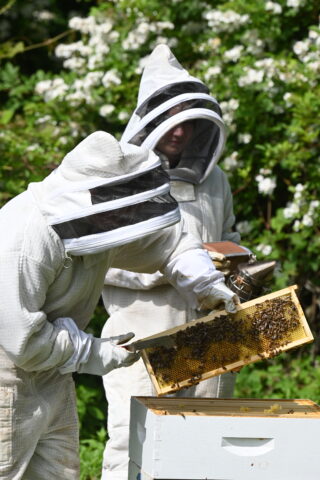As we prepare for the Spring 2025 season at the Norman Bird Sanctuary, I am pleased to share exciting updates regarding the conservation work that is currently underway to benefit our corner of Aquidneck Island. From creating the largest pollinator meadow in the state to removing acres ofinvasive plants and restoring scenic views, the Sanctuary is improving our 300-acre property insignificant ways that positively impact the broader community.
Coastal Field
In the Fall of 2024, we began clearing our Coastal Field south of Hanging Rocks Road of Multiflora Rose, Privet, and Honeysuckle. We excavated and transplanted mature Bayberry plants to the forest adjacent to our Woodland Trail to help reestablish the understory. In February 2025 we eliminated the remaining brush material to prepare the Coastal Field for planting later this season. In early summer we will seed the field with a cover crop of Buckwheat to suppress the growth of invasive species and fertilize the soil; the Buckwheat will be mowed before germinating and a second round will be planted and cut once more before the spring growing season.
This November, we will seed the field with thousands of nutrient-rich pollinator seeds, includingNew England Aster, Bee Balm, Goldenrod, Rudbeckia, and more. The result will be a scenicwildflower field framed by stone walls and the beaches beyond. With continued maintenance, thefield will literally blossom more productively in successive years; as the gardening saying goes, first season sleeps, second creeps, and the third year leaps!
Increasing pollinator habitat is critical to the biodiversity of the local ecosystem. Pollinator species like bees, butterflies, and hummingbirds are essential for a healthy ecosystem. A dedicated pollinator meadow will provide pollinators with the food, shelter, and structure they need to survive and reproduce. Once established, the Coastal Field will be the largest pollinator meadow habitat in Rhode Island.
Historically this field has been preserved primarily for habitat, with limited trail access outside of oureight-week Summer Camp season. In conjunction with the field restoration, we are in the process of planning a more publicly accessible interpretive Coastal Trail highlighting the impacts of a changing climate and how we are addressing this time-sensitive issue.
North Fields
In the heart of the main campus, we are introducing a cyclical mowing approach to managing our fields to help mitigate the negative impacts of invasive plants and improve the quality of the habitat for wildlife.
Grasslands are among the most rapidly disappearing type of habitat in North America, making those here at the Sanctuary – and the bird species they support – especially critical.
Furthermore, the grassland fields lining Third Beach Road contribute to the sense of place and unique character of our community. Over the past six years we have restored more than 1,000 feet of historic stone walls that line the road, significantly improving this section of roadway and extending the useful life of the walls for years to come. We are continuing to invest in these fields through proactive invasive plant management, nest box installation, and data analysis to inform the protection of this important habitat.
In 2024 we observed a never-before-seen invasive Willow species in our North Field, or our “HarvestFair Field.” We have also seen an increase in Multiflora Rose and Poison Ivy in the North Field. Just north of the field is another portion of the property in need of restoration, which we are addressing by removing more than 15 acres of invasive Black Berry, Devil’s Walking Stick, Honeysuckle, and Autumn Olive.
Annually we monitor and collect data regarding the bird activity in the North Field as part of our Nesting Box Program with the Cornell Lab of Ornithology. Based on that data and the site conditions, the nesting boxes will be installed in our northernmost field for this season. This will allow us the opportunity to track activity in a newly cleared field as well as the chance to restore the grassland in the North Field.
South Fields
Our South Fields are home to important warm and cool season grasses, which provide habitat for grassland birds like Bobolinks and Meadowlarks. A critical complementary habitat connected to the grassland is the edge or border adjacent to the fields and stonewalls. This tree canopy supports species like Red-tailed Hawks, Osprey, and other raptors that hunt prey from the elevated vantage point. The layered understory provides habitat for various kinds of wildlife. Using historical information, research, and existing conditions, we will be enhancing this border by removing invasive species and planting an understory of native plants to better support wildlife.
What does this mean and how will it impact you as a neighbor?
Norman Bird Sanctuary is one of the most unique and significant open space resources in RhodeIsland. The work we do to protect and defend this community asset is vital to maintaining these 300 acres for all to enjoy and use.
These conservation efforts will improve the quality of habitat that the Sanctuary provides for wildlife, and in doing so, they will also enhance the community through education, engagement, and quality of place. These changes will restore views to and from the Sanctuary, and they will enrich the 300acres that make up the refuge, as well as the surrounding neighborhood. Greater biodiversity hereat the Sanctuary positively impacts neighboring properties, gardens, landscapes, and habitats.
I invite you to be in touch with any questions. Please feel free to arrange a time for a walking tour ofthis important work. I look forward to sharing more about these efforts and I welcome your input, involvement, and support.
The harbingers of spring – the Woodcock’s call at dusk, Red- winged Blackbirds returning to the landscape,Snowdrops and Crocuses peeking through the soil – bring promise that brighter days are ahead. Whether you arereturning to Middletown from a winter elsewhere or just emerging from winter hibernation, I look forward toseeing you at the Sanctuary soon.
Warmly,
Kaity Ryan Executive Director
